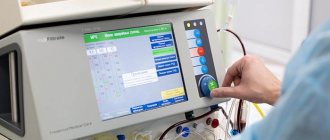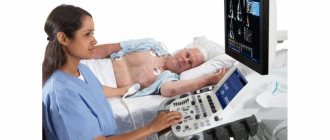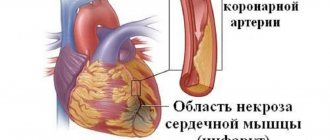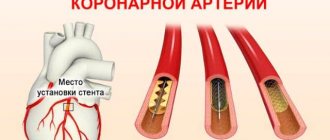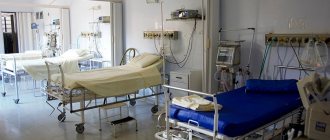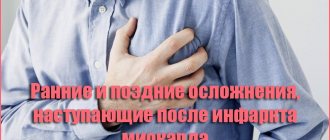How is myocardial infarction treated in a hospital and how long do they stay in the hospital?
Medical care for myocardial infarction is aimed primarily at preserving the patient’s life. Then doctors try to limit the affected area and prevent the occurrence of heart failure. The following treatment phases are distinguished:
- Urgent actions. Includes diagnosis and pain management.
- Early help. Initiation of reperfusion therapy, treatment of shock, arrhythmias, acute heart failure.
- Prevention of future complications.
- Risk assessment and control over the progress of existing pathologies.
If the course of events is favorable, the patient is admitted to the hospital already at the stage of emergency measures.
Medical and medical supervision
Treatment with medications plays a leading role in preventing possible relapses. In the post-infarction period, the following drugs are prescribed:
- Means for reducing blood viscosity: Plavix, Aspirin, Tiklid.
- Drugs for the treatment of arrhythmia, angina pectoris, hypertension (depending on what disease led to the development of a heart attack): beta-blockers, nitrates, calcium antagonists, angiotensin-converting enzyme inhibitors.
- Drugs for the prevention of atherosclerosis: fibrates, statins, bile acid sequesters, nicotinic acid.
- Preparations for improving metabolic processes in tissues: Solcoseryl, Actovegin, Mildronate, Piracetam.
- Antioxidants: Riboxin, vitamin E.
In addition, annual monthly courses of multivitamin complexes , which will help strengthen the body and prevent the harmful effects of external factors on the state of the cardiovascular system.
What hospital procedures are performed on a patient with MI?
| Type of procedure | The essence of manipulation | Expected Result |
| Cardiopulmonary resuscitation | Supporting basic vital functions of the body | Patient Rescue |
| Electrical defibrillation | ||
| Recording an electrocardiogram | Registration of cardiac performance indicators | Diagnosis confirmation |
| Intravenous injections | Delivery of medications to the body | Correction of pathological symptoms, reducing the likelihood of complications |
| Percutaneous (percutaneous) coronary interventions | ||
| Coronary artery bypass surgery | Placement of a connection (shunt) between the aorta and coronary vessel below the site of blockage by a blood clot | Restoration of blood supply to the myocardium thanks to an additional path for blood flow |
| Stenting | Expansion of a pathologically narrowed coronary vessel using a cylinder made of synthetic materials | Reperfusion of the heart muscle by expanding the lumen of a blocked vessel with a stent |
(Patients with cholesterol levels less than 4.5 mmol/l are prescribed according to the decision of the attending physician).
Additionally, medications are prescribed for a heart attack in the hospital. But only if the patient’s condition requires this.
These are the following medical products:
- narcotic and non-narcotic analgesics (for severe pain);
- ACE inhibitors (treatment of arterial hypertension);
- diuretics (for acute left ventricular failure, pulmonary edema);
- antiarrhythmic drugs (for blockades and tachyarrhythmias);
- long-term oral anticoagulants (in the presence of blood clots in the cavity of the left ventricle).
Emergency treatment at the prehospital stage
Primary emergency care is provided by ambulance doctors. First, they intravenously administer drugs to relieve acute pain: Analgin or narcotic analgesics in the form of Morphine, Promedol and others.
In some cases, it is necessary to combine such drugs with antihistamines Diphenhydramine or Pipolfen.
The administration of sedatives is also required. Intravenous injections provide a quick effect. After all these measures, an electrocardiogram is performed.
During first aid, the patient is taken to a medical facility. All these actions must take place within half an hour. If this is not possible, then thrombolytic drugs are urgently injected into the vein.
To relieve the load on the heart muscle, oxygen inhalations are performed in the ambulance.
How long does a patient with a heart attack stay in the hospital?
The logical end of the inpatient stage of treatment should be the restoration of the patient’s physical activity. There are several stages of mode expansion:
- The first 12-48 hours are in intensive care, movement is prohibited. This time is enough for doctors to eliminate the possibility of complications.
- 3-4 days – allowed to sit down and eat food independently. At this stage, light crushed food is what can be transferred to the hospital in case of a heart attack.
- 5-6 days - you are allowed to get up, and at the end of the first week - to walk around the ward. If complications of myocardial infarction occur (heart failure, shock, severe arrhythmias), then the patient should follow the rules of bed rest longer and extend it more slowly.
- From the 12th day the patient begins to climb stairs (2 steps are added every day).
Mandatory hospital treatment should be at least 10-14 days.
What determines the length of hospitalization?
Psychological help for this problem
A person who has survived a heart attack is often susceptible to depression . His fears are well founded - after all, the attack could happen again. Therefore, in the post-infarction period, psychological rehabilitation is given a special place.
The main goals of psychotherapy are the prevention of neuroses, normalization of mental state, elimination of phobias and sleep problems.
To eliminate the patient’s fears, relaxation techniques and motivation to work .
The psychologist usually works with the patient's relatives . Often, after a heart attack, they begin to consider the patient disabled, surround him with excessive care and try to limit his physical activity - this attitude has a bad effect on the patient’s psychological state and makes it difficult for him to return to a full life.
conclusions
The medical histories of patients who are hospitalized with myocardial infarction vary. Each case is individual. Some suffered extensive damage to the heart muscle, while others suffered a micro-infarction. However, the principles of treating this pathology are the same.
The basis of inpatient treatment of a heart attack is the following tasks: limit the area of necrosis, relieve symptoms, and prevent complications. For a speedy recovery, the patient must follow the prescribed regimen.
Patients who have suffered a myocardial infarction are recommended to be under the supervision of a doctor from the clinic for the rest of their lives. Visits to a medical facility once a year are required.
The following sources of information were used to prepare the material.
General rules
Serious cardiac pathologies with subsequent complications in the form of a heart attack require hospitalization and long-term treatment under constant medical supervision. For the first three days, the patient is in intensive care, then he is transferred to the cardiology department and given time to recover. The course of therapy for people who have had a heart attack is divided into two stages:
- Spicy . Lasts up to two weeks from the moment the attack first appears. Involves intensive therapy: bed rest, monitoring the current condition using equipment.
- Subacute – from 3 to 4 weeks . The patient is in the hospital, where doctors are trying to improve his health and prevent complications from developing.
No one can keep a patient in the clinic by force. He has the right to leave the walls of the hospital on his own as soon as he feels better, but then the doctors will relieve themselves of responsibility for his life. Rapid discharge is fraught with serious consequences, for example, the development of thromboembolism, CHF, and aneurysms. Supervision by qualified professionals reduces risks.
Staying in hospital is the basis for subsequent recovery at home: receiving advice on the upcoming regimen and providing timely assistance in case of complications.
Traditional methods of treatment
Discharge from the hospital does not mean complete recovery. The patient will be prescribed medications, physical therapy and other methods to speed up recovery. You can supplement the treatment regimen with traditional medicine. They cannot completely cure a person, but they can increase the effectiveness of the main course of therapy.
Various tinctures, infusions and decoctions contain natural ingredients designed to saturate the heart with beneficial substances and reduce nervous excitability. They can be used after the approval of a cardiologist, so as not to disrupt the basic therapy regimen and not increase the chance of developing complications.
Cereals
Cereals are represented by rye, wheat, oats and other plants from this family. They are rich in vitamins and microelements necessary for the proper functioning of the heart. Their greatest quantity is in just sprouted grains. They are easier to digest, therefore, the body will be saturated with useful substances to a greater extent than when eating simple porridge.
To germinate grain in order to use it as a treatment after a heart attack at home, you can use the “jar” method:
- Prepare a jar, for example, of mayonnaise or tomato paste, grain in the amount of 2/3 of the intended size of the container, gauze and a tray (preferably glass).
- Pre-treat the grain: initially it is better to apply potassium permanganate (25%) and then pour boiling water over it.
- Fill the prepared container approximately 70% with processed grain. Pour water on top. It is advisable that it be cleaned, since the quality of the sprouts will depend on this.
- After 12 hours, drain all the liquid from the container. Next, place gauze rolled in 4 layers and soaked in water on the surface of the glass tray. Place the sprouted sprouts on top. Then cover the grain with four more layers of damp gauze.
After 2 days, the length of the sprouts will be approximately 1 cm. Special lamps of the “Flora” type will help accelerate growth. To prevent the process from slowing down, it is necessary to maintain the temperature (about 20-25°) and control the humidity.
The greatest benefit to the body comes from the newly emerging white sprouts, although some experts note the healing effect of green shoots. It is advisable to accustom yourself to them gradually, starting with adding 1-2 tsp to your diet. and ending with 1-2 tbsp. l. (after a couple of months). Dishes into which sprouted grains will be poured should not be hot, as their value will be lost due to heat treatment.
Herbs
Herbs with healing properties have beneficial substances necessary for the body and extremely rarely cause adverse reactions. They can be used as treatment after a heart attack for a long time (over 2 months).
The medicine must be prepared strictly according to the prescription:
- Take in equal parts:
- motherwort;
- immortelle;
- white willow bark;
astragalus;
- clover;
- valerian;
- fennel;
- wild rosemary;
- cottonweed.
Birch buds
Birch buds can speed up the regeneration process, cleanse the blood, relieve inflammation and reduce the amount of circulating blood by removing excess moisture. Buds, leaves and juice are suitable for preparing medicines. The decoction is made according to this recipe:
- 10 g of birch buds pour 200 ml of boiling water;
- put the container on the fire and cook for 15 minutes;
- After cooling, remove the raw materials;
- drink 120 ml between meals.
Instead of a decoction, you can make a tincture:
- 1 tbsp. l. kidneys pour 500 ml of alcohol;
- place the container away from the sun for 2 weeks;
- shake the tincture every day;
- drink 15 ml 2-3 times a day.
Mumiyo
An aqueous solution of mumiyo is used as a complement to the treatment of many pathologies of the heart muscle. The product is valued for its ability to improve myocardial nutrition, thereby restoring the normal rhythm of contractions. It should be used according to generally accepted instructions:
- A 2% mummy solution is used starting with 13 drops. Gradually increase the amount to 1 tsp. (40 drops).
- Take the medicine before meals for 2 weeks. Then take a break. After 14 days, continue treatment. A total of 5 courses are required.
Garlic
Garlic helps normalize blood clotting and reduce cholesterol levels. Its mixture with honey and lemon helps well after a heart attack:
- chop 1 head of garlic and 3 lemons;
- mix the ingredients and pour 30 ml of honey on top;
- close the container and let it brew for a week;
- take 100 g every day.
Valerian
Valerian has a pronounced sedative property. You can prepare it in its pure form or by adding an infusion of calendula, sage, lavender and angelica. All components are taken in equal shares. Then you need to follow this recipe:
- Pour 120 g of collection into 1 liter of boiling water and close the container tightly overnight;
- in the morning, remove the raw materials from the broth;
- take 2 times a day, 1/3 cup for 2 months.
Hawthorn
Hawthorn is used to stabilize the heart and reduce nervous excitability. An infusion can be made from it according to this recipe:
- Grind 30 g of hawthorn fruit and pour a glass of boiling water;
- after cooling, remove the raw materials;
- drink 250 ml after waking up and before going to bed.
Motherwort
Treatment of a heart attack with folk remedies often includes an infusion of motherwort. It calms and increases the effectiveness of drugs with anticonvulsant and antiarrhythmic effects. The medicine is prepared similarly to hawthorn infusion. It is recommended to use it 120 ml 3-4 times a day.
Sprouted wheat
Wheat can be used to treat cardiovascular diseases due to its composition, rich in magnesium, calcium and other elements. Its sprouted sprouts are especially effective. They can be added to the daily menu (salads, drinks, mixtures, juices) or eaten pure in the morning in the amount of 30 g for a long time.
Honey
Honey is rich in glucose, which improves nutrition of the heart muscle by dilating coronary vessels. You can prepare a useful medicine by adding other components:
- take 100 g of kernels of nuts, raisins, dried apricots and chop thoroughly;
- pour 100 ml of honey into the mixture;
- use the product 1 tbsp. l. 2-3 times a day.
The following recipe is no less effective:
- twist 1 kg of rowan;
- pour 2 liters of honey into the mixture;
- take the medicine 30 g daily.
Time frame for a patient in intensive care
Patients with an acute attack of myocardial infarction immediately after the pain syndrome receive medical care in the intensive care unit (ICU). Urgent medical measures are carried out there. At this stage, doctors strive to maintain optimal oxygen supply to the myocardium and maintain its viability. The patient is given rest, painkillers, sleeping pills and drugs to lower the pulse are prescribed.
The duration of the course of therapy depends on the patient’s condition and the success of his recovery. There are no exact dates, but the standard duration of stay in intensive care is three days, if there are no consequences and the person is conscious and has not fallen into a coma.
While the patient is under the care of resuscitators, he must undergo the following types of surgical intervention:
- cardiac catheterization (examination of the coronary artery);
- angioplasty (dilation or narrowing of damaged blood vessels);
- CABG – coronary artery bypass grafting (restoration of blood flow).
In addition, the patient is administered drugs that eliminate blood clots. All procedures usually take 3-7 days. The hospital stage ends in the cardiology department. Modern medicine speeds up the healing process.
Diagnosis of the disease
Before treatment, the doctor conducts the following studies:
- MRI (magnetic resonance imaging). Thanks to this expensive examination, even the smallest areas of damage can be identified.
- An ECG (electrocardiogram) reveals signs of a heart attack; the procedure is quick and inexpensive.
- EchoCG (echocardiography) is a safe ultrasound procedure that reveals the location of the lesion, the condition of blood vessels and blood flow, and the presence of blood clots.
- Myocardial scintigraphy. Thanks to the injected contrast agent, the affected area is clearly visible on the image.
- Tests for biochemical markers. An increase in some indicators usually indicates a heart attack, but can also be caused by other reasons.
- Cardiac catheterization.
The subsequent treatment regimen depends on the diagnostic results and the severity of the heart attack.
Terms of subsequent rehabilitation
After a heart attack, it is recommended to remain under medical supervision for up to 28 days. The cardiologist must present a plan for further rehabilitation measures that will return the heart muscle to the ability to contract in its usual rhythm.
The speed of recovery depends on several factors:
- Was help provided in a timely manner during the attack?
- Age of the patient (if less than 70 years old, they will be sent home faster).
- General state.
- Complications.
- Type of heart attack.
Based on the depth of damage to the heart muscle, there are two types of lesions: transmural and non-transmural infarction. In the first case, the focus of necrosis involves all or most of the heart muscle. In the second, parts of the left ventricle are affected. The general recovery period for minor necrosis is 6 months; an extensive heart attack with complications doubles the period, because each stage of recovery is slower.
Discharge can be made as soon as possible (7-10 days after staying in BRIT) only if the following conditions are met:
- the heart rhythm was restored;
- consequences have not been identified;
- the patient is less than 70 years old.
Rehabilitation continues after discharge. The person is prescribed constant medication, a special diet, giving up bad habits (smoking, drinking alcohol) and regular rest. Restrictions are imposed on many areas of life. The patient may be sent for home treatment or given a voucher to a specialized cardiological sanatorium. Adaptation involves special exercises, medication, and diet.
The standard period for returning to normal in a sanatorium is 18-21 days. A specialist will tell you more about this in the video:
People with non-transmural lesions are prohibited from strenuous exercise in the gym, but are allowed to walk and engage in physical therapy. Survivors of transmural infarction are treated in a sanatorium for the first year after the attack.
The time spent in the hospital after a heart attack from attack to complete recovery cannot be determined by a common denominator. Everything is strictly individual. But modern practice is such that the number of seriously ill patients is decreasing, and doctors strive to discharge the patient from the hospital as soon as possible (10-14 days after a heart attack).
Diet features
In the first weeks after the attack, you must follow a strict diet. The patient's diet should consist of light soups, cereals, and low-fat fermented milk products. All dishes are eaten pureed without adding spices, including salt. Portions should be reduced as much as possible, and the number of meals increased to 6-7 per day. Carrot juice in combination with vegetable oil will bring particular benefits to the body (in the ratio of 250 ml of juice per 1 tsp of oil). It is recommended to drink it in the first days after an attack, 1 glass per day, dividing it into 2 doses.
A month after a heart attack, a weakening of the diet is allowed. Patients will be able to eat normally, but when drawing up the menu they will have to take into account the recommendations of specialists:
- Add sprouted sprouts, which belong to the cereal family, and bran to your diet.
- Reduce the amount of salt consumed, as well as fried, smoked and fatty foods.
- Instead of canned food and sweets, use fresh fruits, vegetables, dried fruits and honey.
- Replace coffee and black tea with infusions and decoctions of medicinal herbs (hawthorn, rose hips, valerian) and freshly squeezed juices (cranberries, carrots).
- Go to 4-5 meals a day. It is advisable to reduce portions to medium sizes so as not to convey it (you need to leave the table with a slight feeling of hunger). Eating before bed is contraindicated and it is advisable to drink a glass of kefir or any other fermented milk product.
- Avoid seasonings (mustard, horseradish, pepper) and foods with high amounts of cholesterol.
- Enrich the menu with fermented milk products. It is advisable to choose the smallest percentage of fat content.
- Prepare by boiling, baking or steaming. A double boiler will be an excellent helper.
- Among the soup recipes, choose vegetarian ones (without adding meat products).
- Reduce the number of eggs consumed to 2-3 per week.
How is myocardial infarction treated in a hospital and how long do they stay in the hospital?
Medical care for myocardial infarction is aimed primarily at preserving the patient’s life. Then doctors try to limit the affected area and prevent the occurrence of heart failure. The following treatment phases are distinguished:
- Urgent actions. Includes diagnosis and pain management.
- Early help. Initiation of reperfusion therapy, treatment of shock, arrhythmias, acute heart failure.
- Prevention of future complications.
- Risk assessment and control over the progress of existing pathologies.
If the course of events is favorable, the patient is admitted to the hospital already at the stage of emergency measures.
Which doctors should you contact if you have a heart attack?
- Ambulance team
- Cardiologist
An objective examination of the patient reveals pale skin with cyanosis of the lips, the skin is moist and cold. At the very beginning of the disease, bradycardia and a short-term increase in blood pressure are observed. Subsequently, tachycardia and hypotension usually develop. When listening to the heart, a weakening of the first sound above the apex of the heart is detected; in a third of patients, a protodiastolic gallop rhythm can be heard, which can be an early and even the only symptom of heart failure.
The presystolic gallop rhythm does not always indicate cardiac decompensation; it may be associated with conduction disturbances. A systolic murmur can also be heard above the apex of the heart due to relative mitral valve insufficiency and mastoid muscle dysfunction. This type of onset of acute myocardial infarction is not observed in all cases.
Great difficulties in diagnosing myocardial infarction arise from forms with oligosymptomatic or asymptomatic course. In such cases, the disease begins with an incomprehensible general weakness, vague chest pain. Ignoring such complaints often leads to death.
The main method for verifying the diagnosis of myocardial infarction is an executive analysis of the clinical picture and electrocardiographic criteria for coronary circulatory disorders.
Large-focal and transmural myocardial infarction, according to ECG data, is characterized by a staged course: acute and subacute periods, a period of scarring. If the dynamics of these changes stop and the electrocardiogram freezes in the phase of the acute (more than 15-20 days) or subacute (more than 3-4 weeks) period, then the occurrence of an acute or subacute cardiac aneurysm should be assumed, which develops in approximately 20% patients with myocardial infarction. This is a limited protrusion of the wall of the left ventricle. The necrotic area of the heart, having lost the ability to contract, stretches and protrudes under the influence of intraventricular pressure. Chronic cardiac aneurysm develops less frequently - during the period of scarring due to stretching of the fragile scar.
Already during the first day of the disease, signs of necrotic syndrome appear, caused by the breakdown of the muscle fibers of the heart and the absorption of autolysis products. It is characterized by fever, leukocytosis (from the 1st to the 4th-5th day), a shift in the leukocyte formula to the left, an increase in ESR (from the 6th-7th day), an increase in the levels of troponins I and T in the blood, and the activity of some blood enzymes ( AST), CPK enzyme (MB-CPK), myoglobin, C-reactive protein.
Since the main symptom of myocardial infarction is chest pain, differential diagnosis should be carried out with diseases that are accompanied by pain in the left half of the chest.
What hospital procedures are performed on a patient with MI?
| Type of procedure | The essence of manipulation | Expected Result |
| Cardiopulmonary resuscitation | Supporting basic vital functions of the body | Patient Rescue |
| Electrical defibrillation | ||
| Recording an electrocardiogram | Registration of cardiac performance indicators | Diagnosis confirmation |
| Intravenous injections | Delivery of medications to the body | Correction of pathological symptoms, reducing the likelihood of complications |
| Percutaneous (percutaneous) coronary interventions | ||
| Coronary artery bypass surgery | Placement of a connection (shunt) between the aorta and coronary vessel below the site of blockage by a blood clot | Restoration of blood supply to the myocardium thanks to an additional path for blood flow |
| Stenting | Expansion of a pathologically narrowed coronary vessel using a cylinder made of synthetic materials | Reperfusion of the heart muscle by expanding the lumen of a blocked vessel with a stent |
(Patients with cholesterol levels less than 4.5 mmol/l are prescribed according to the decision of the attending physician).
Additionally, medications are prescribed for a heart attack in the hospital. But only if the patient’s condition requires this.
These are the following medical products:
- narcotic and non-narcotic analgesics (for severe pain);
- ACE inhibitors (treatment of arterial hypertension);
- diuretics (for acute left ventricular failure, pulmonary edema);
- antiarrhythmic drugs (for blockades and tachyarrhythmias);
- long-term oral anticoagulants (in the presence of blood clots in the cavity of the left ventricle).
Restoring the patency of the coronary vessels
Nitroglycerin and beta-blockers have a complex effect on the body. With their help, the lumen of the coronary arteries also increases.
Reducing the vascular lumen reduces blood flow to the heart. If there is no effect from medications, surgical treatment is performed. To do this, a stenting procedure is performed.
Also read: Main signs of post-infarction cardiosclerosis
The procedure is performed using special expanders called coronary stents. They are installed in a vessel and a reliable and complete restoration of blood circulation is achieved.
How long does a patient with a heart attack stay in the hospital?
The logical end of the inpatient stage of treatment should be the restoration of the patient’s physical activity. There are several stages of mode expansion:
- The first 12-48 hours are in intensive care, movement is prohibited. This time is enough for doctors to eliminate the possibility of complications.
- 3-4 days – allowed to sit down and eat food independently. At this stage, light crushed food is what can be transferred to the hospital in case of a heart attack.
- 5-6 days - you are allowed to get up, and at the end of the first week - to walk around the ward. If complications of myocardial infarction occur (heart failure, shock, severe arrhythmias), then the patient should follow the rules of bed rest longer and extend it more slowly.
- From the 12th day the patient begins to climb stairs (2 steps are added every day).
Mandatory hospital treatment should be at least 10-14 days.
What determines the length of hospitalization?
Is disability required or can you return to work?
The patient’s ability to work is determined by several parameters:
- electrocardiography indicators;
- clinical examination results;
- laboratory test data;
- data from a bicycle ergometer study.
Persons who experience daily angina attacks that cannot be treated, as well as congestive heart failure, are recognized as disabled.
Restoration of working capacity depends on the individual characteristics of the course of the disease. The decision on the possibility of carrying out this or that activity is made by a special commission.
After a heart attack, it is prohibited to engage in the following types of professional activities : driving vehicles, heavy physical work, daily and night shifts, as well as work that requires increased attention and is associated with psycho-emotional stress.
conclusions
The medical histories of patients who are hospitalized with myocardial infarction vary. Each case is individual. Some suffered extensive damage to the heart muscle, while others suffered a micro-infarction. However, the principles of treating this pathology are the same.
The basis of inpatient treatment of a heart attack is the following tasks: limit the area of necrosis, relieve symptoms, and prevent complications. For a speedy recovery, the patient must follow the prescribed regimen.
Patients who have suffered a myocardial infarction are recommended to be under the supervision of a doctor from the clinic for the rest of their lives. Visits to a medical facility once a year are required.
The following sources of information were used to prepare the material.
